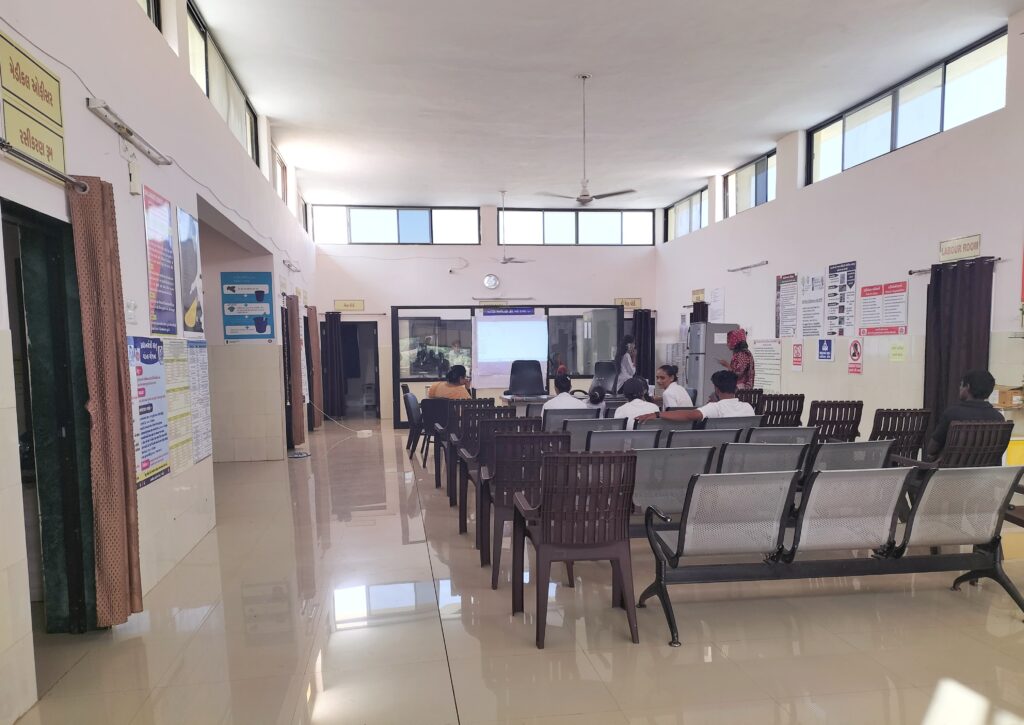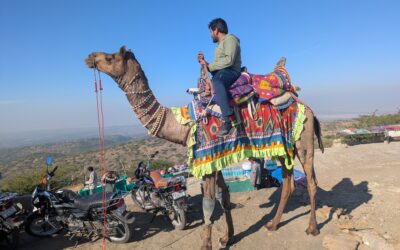primary [adjective]: of chief importance; principal.
The vision of the National Health Mission (NHM) is “to ensure progress towards the goals and targets set out in the National Health Policy, 2017 for ensuring universal access to equitable, affordable and quality health care services, accountable and responsive to people’s needs”.
This is what one would read if we were to visit the official website of the NHM. In the absence of quality healthcare hospitals, the Government of India decided to sprinkle Primary Health Centre (PHCs) or Prathmik Arogya Kendra as they are popularly called today across the rural and urban spaces of India. And they have done an incredible task in establishing one such PHC in Baranda, Kutch, Gujarat.

The pretty tiles and high ceilings of Baranda PHC welcomes all those who visit this Arogya Kendra. The rooms are titled on neatly printed plates, each indicating the purpose of all the rooms in the PHC. The space boasts hygiene and is decently equipped to deal with basic testing abilities. The seating seems adequate for the population that visits. There are charts all over the walls, each providing primary, important information to all its visitors.

An AYUSH Medical Officer sits in his dedicated office, while people walk into a cabin: the reception area. The PHC also has a laboratory and testing lab.
All seems well in the PHC. So then, what is the problem?
The Pre-
pre- [prefix]: before (in time, place, order, degree, or importance)
The PHC is located at a distance not easily accessible to the population of the block it caters to. The interiors of Kutch lack connectivity. With considerable distances between the villages, and lack of transportation, the “Primary” no longer remains of chief importance to the people. Moreover, the amount of fuel given for PHC ambulance(s) often prove insufficient for the entire month. If you miss the only two buses going towards the PHC, you are now to be atmanirbhar. You couldn’t fall ill based on the bus timings? Boohoo-poor you!
A good thing about government structures and the healthcare practitioners placed there is the fact that the patients do not get charged mindlessly; a common practice often evident in private institutions. But people here do not prefer that. While the doctors and the nurses at PHC give the required dosage of medicine, the people here prefer a stronger dose of the medicine. They believe that this helps them get better quicker, and their entire trip would prove worthwhile, even if it means going the extra mile, both literally and materially.
As mentioned earlier, the PHCs are placed based on the population of a particular geographical area. Upon further division, there are sub-centers placed at regions with lesser populations. In a village called Pipar in the Lakhpat taluka of the Kutch district, the story is a bit different. While the grant for the sub-centre here has been approved on paper, the village is yet to receive the same. The existing structure of the sub-centre must be demolished before a new sub-centre can be constructed in it place. In such cases, the people are often asked to visit community halls and school structures that act as makeshift sub-centres to the ailing.
Doctor? Nurse? Anyone?
While ANMs are meant to be the first point of contact for patients seeking assistance from PHCs and sub-centres, there are not enough of them for the community here. The ANMs and Asha workers live in far off places and prefer visiting villages based on the requirements of the people. As they are often allotted 5-6 villages and their sub-centres, even visiting more villages throughout the day, given the distances between the, becomes a task.
Additionally, an AYUSH doctor sits at the Baranda PHC and performs the duties of a Medical Officer. The healthcare staff at PHCs like Baranda are on a contractual basis, and fails to provide utmost stability to the community members. In general, Gujarat has witnessed a shortage of staff in their government healthcare structures.
The Post
post- [prefix]: after (in time, place, order, degree, or importance)
The Jan Arogya Samiti (JAS) is a committee that plays an important role in the budgeting and governance process for the PHCs. While it is mandatory for Panchayat members to be part of the JAS, the same is often not the case. But exceptions are present her too! If implemented efficiently, the mandate would not only create a space for transparency and accountability, but would also contribute towards building a sense of ownership to the Panchayats.
The lack of connectivity to the internal villages proves to be a challenge. There can be attempt made to improve roads which disappear during rains in the interiors of the region. Similarly, either the fuel charges can be allocated more budget. Certain non-profits, like SETU Abhiyan does, can provide aid and services related to the people in collaboration with the PHC. The buses could be asked to travel more frequently as well.
The PHCs are also responsible for referring women to government hospitals, including those requiring pre-natal and post-natal care. But the same is done only when minimum number of women require such services. In the absence of sonography services in PHCs, the people, once again, prefer going to further locations and paying extra for services. There is also fear and lack of trust surrounding PHCs and lack of services. They believe that other healthcare structures could prove more beneficial, for example, in instances such as blood loss, and requirement of more blood in case of emergencies. For this, it is imperative that services must be provided within accessible reach of the community.
Thoughts, And Prayers
Doctors are often seen as another form of God(s). So why are the physical manifestations of our gods absent in these Arogya Mandirs? Getting placed in regions like Lakhpat is often seen as ‘punishment’ by many. And you cannot get punished any further away from the rest of the country as your next stop would be in Pakistan. This contributes to the indifferent mindset of the doctors and nurses placed here, often not voluntarily. The lack of facilities and services anyway does not motivate the community to visit PHCs or sub-centres.

There are plenty of people availing plenty of services in the region, and across the country. But there is always scope for improvement, yes? It is a good thing that the structures are in place. We just need to work on the quality and implementation of services. And if we can’t? We can always pray in our Arogya Mandirs and hope for the best!




0 Comments